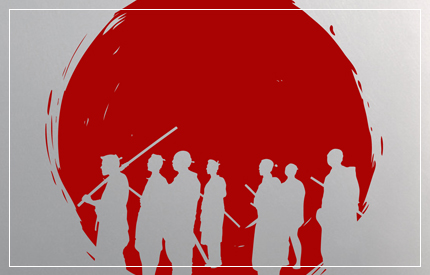Protect Others, Save Yourself...
Date: 23/04/2014
Movie Review

This spring sees the British Film Institute (BFI) celebrate the 60th anniversary of one of the most celebrated works in Japanese cinema: Akira Kurosawa's Seven Samurai. The film's enduring charm and legacy is to be re-asserted and introduced to a new generation with a Limited Edition Steelbook Blu Ray release on 21 April, along with a DVD issue remastered in HD.
Kurosawa's Seven Samurai follows the story of a small farming village in rural Japan that continually suffers at the hands of plundering bandits. Following a meeting with the village patriarch, Gisaku, it is decided that the only course of action left is to hire samurai to defend the community and dispose of the bandits once and for all.
A small group of villagers sets off on a mission and eventually crosses the path of Kambei Shimada; a wise, war-weary rōnin - a masterless samurai - who they witness coming to the saviour of another village by rescuing a small child from the clutches of a thief. Kambei agrees to help the villagers and begins the process of searching for other samurai to join the collective. They enlist Katsushirō Okamoto, a young, untested but enthusiastic fighter who is impressed by Kambei's rescue operation and Kikuchiyo, a would-be samurai who initially appears a drunken, angry wreck, but eventually emerges as one of the film's most popular and memorable characters.
Four more fighters are assembled: Shichirōji, who had formerly been Kambei's lieutenant; Gorōbei Katayama, a strong archer who takes the role of second in command; Heihachi Hayashida, a kind and charming samurai with a light-hearted sense of humour and Kyūzō, a highly-skilled yet modest swordsman who becomes a hero to the young Katsushirō.
The Seven Samurai set about preparing the village and its residents for battle against the bandits, who are meanwhile biding their time in the surrounding hills until the rice has been harvested. By the film's close, both sides will engage in battle and one will emerge the victor, as Kurosawa's gritty, realist drama draws to its violent conclusion.
The influence of Seven Samurai on cinema as a whole cannot be overlooked. Echos of Kurosawa's vision are found most notably in the Star Wars franchise, which mirrors the film both in its aesthetic and in its notions of honourable combat and skilled swordsmanship. In terms of thematic material, the young Katsushirō's infatuation with local villager Shino could be seen as an early influence on the Luke/Leia interaction in A New Hope, while the facial expressions and body movements made by the contemplative Kambei bear more than a striking resemblance to the character of Yoda throughout the franchise. The film was, of course, also 'westernised' for American audiences in John Sturges' The Magnificent Seven in 1960.
Many of the tropes now popular in modern cinema find their origins in Seven Samurai. Critics argue that the film was the first to introduce the idea of disparate heroes being assembled in order to achieve a common goal, while Kambei's rescue of the small child at the beginning of the film is seen as setting a precedent for the technique of introducing a central character through a feat of heroism unrelated to the plot.
The film's influence is also seen in the violent Lone Wolf And Cub series of the 1970s, which received acclaim both in Japan and in Europe and follows a rōnin who pushes his child in a bamboo cart through a rural wasteland, slaying enemies and getting into adventures along the way. The character of Lone Wolf as an undefeatable, skilled samurai, yet who ultimately represents morality and humility, clearly drew heavy influences from the character of Kyūzō, who emerges in Seven Samurai as a supreme, respected warrior.
Yet despite its influence on cinematic depictions of war, Kurosawa actually treats violence as anything but elegant. While the samurai are masters of ingenuity and skill in battle, both death and killing are presented mostly as clumsy, inelegant pursuits that are hard won and come at a cost. The apparent glee with which the samurai despatch the invading bandits seems at odds with our more contemporary notions of modest, clear cut 'good guys', as the plan is not simply to defend the village until the bandits leave them alone; it is to trap them and kill them, one by one, taking no prisoners. Kurosawa's treatment of violence is unsurprising, considering the film was made in 1954 when Japan was still reeling from the aftermath of the Second World War.
Yet despite the film's grittiness and realist, unpolished depiction of battle, Seven Samurai is awash with cinematic elegance and visual artistry. Virtually every scene contains beautiful, iconic imagery that highlights both Kurosawa's skill as a director and the artistic power of the Japanese aesthetic. It's almost as if Kurosawa is harking back to the country of his samurai ancestors; a nationalistic remedy to the uncertainty, self-doubt and disease present in post-war Japan.
In terms of the film's social commentary, the most obvious aspect is its, David vs. Goliath theme, which propounds the benefits of collectivism over individualism. As Kambei points out, in war, individual action harms the individual, while collective action protects the individual.
Seven Samurai is set in the late 16th century, during what would become known as the 'Warring States Period' in Japanese history, when many warlords lost their holdings, samurai lost their positions and lawlessness and unemployment gripped the country. Perhaps Kurosawa means to argue that, in the face of insurmountable opposition, collective will can forge a better future for the common man.
At times, Seven Samurai is almost Brechtian in its treatment of the rural classes. While the farmers are often depicted as clueless, weak and intensely pessimistic, Kurosawa ultimately encourages the audience to feel sympathy with their plight. When Kikuchiyo uncovers a stockpile of armor and weapons that the villagers have stolen from the lone, wandering samurai that came into the village, the seven warriors are appalled by what they see as dishonour in the plundering of dead samurai's possessions. Kikychiyo, however, reveals his peasant upbringing by coming to the defence of the villagers, arguing that the hardships experienced by farmers often lead them to desperate measures. It emerges that Kikychiyo was himself the abandoned son of a farming family, and so sympathises with the villagers. He, in turn, encourages the samurai to do the same.
Kurosawa rarely offers a simplistic explanation as to the actions of characters in the film, preferring instead to depict human beings as complex and oft-misunderstood characters who are capable of change.
Ultimately, Seven Samurai is a rounded action film that deals with issues such as love, loss, death, war and the struggle and development of the human character. The 190-minute running time might paint it as a cinematic ordeal, but in reality Seven Samurai is as simplistic in its storyline as any contemporary Hollywood blockbuster. It is in the expert treatment and development of its characters, its subtle presentation of human society and, ultimately, Kurosawa's inimitable sense of cinematic aesthetic, that Seven Samurai has truly earned its place as a timeless, cultural milestone.
By Iain Todd
Kurosawa's Seven Samurai follows the story of a small farming village in rural Japan that continually suffers at the hands of plundering bandits. Following a meeting with the village patriarch, Gisaku, it is decided that the only course of action left is to hire samurai to defend the community and dispose of the bandits once and for all.
A small group of villagers sets off on a mission and eventually crosses the path of Kambei Shimada; a wise, war-weary rōnin - a masterless samurai - who they witness coming to the saviour of another village by rescuing a small child from the clutches of a thief. Kambei agrees to help the villagers and begins the process of searching for other samurai to join the collective. They enlist Katsushirō Okamoto, a young, untested but enthusiastic fighter who is impressed by Kambei's rescue operation and Kikuchiyo, a would-be samurai who initially appears a drunken, angry wreck, but eventually emerges as one of the film's most popular and memorable characters.
Four more fighters are assembled: Shichirōji, who had formerly been Kambei's lieutenant; Gorōbei Katayama, a strong archer who takes the role of second in command; Heihachi Hayashida, a kind and charming samurai with a light-hearted sense of humour and Kyūzō, a highly-skilled yet modest swordsman who becomes a hero to the young Katsushirō.
The Seven Samurai set about preparing the village and its residents for battle against the bandits, who are meanwhile biding their time in the surrounding hills until the rice has been harvested. By the film's close, both sides will engage in battle and one will emerge the victor, as Kurosawa's gritty, realist drama draws to its violent conclusion.
The influence of Seven Samurai on cinema as a whole cannot be overlooked. Echos of Kurosawa's vision are found most notably in the Star Wars franchise, which mirrors the film both in its aesthetic and in its notions of honourable combat and skilled swordsmanship. In terms of thematic material, the young Katsushirō's infatuation with local villager Shino could be seen as an early influence on the Luke/Leia interaction in A New Hope, while the facial expressions and body movements made by the contemplative Kambei bear more than a striking resemblance to the character of Yoda throughout the franchise. The film was, of course, also 'westernised' for American audiences in John Sturges' The Magnificent Seven in 1960.
Many of the tropes now popular in modern cinema find their origins in Seven Samurai. Critics argue that the film was the first to introduce the idea of disparate heroes being assembled in order to achieve a common goal, while Kambei's rescue of the small child at the beginning of the film is seen as setting a precedent for the technique of introducing a central character through a feat of heroism unrelated to the plot.
The film's influence is also seen in the violent Lone Wolf And Cub series of the 1970s, which received acclaim both in Japan and in Europe and follows a rōnin who pushes his child in a bamboo cart through a rural wasteland, slaying enemies and getting into adventures along the way. The character of Lone Wolf as an undefeatable, skilled samurai, yet who ultimately represents morality and humility, clearly drew heavy influences from the character of Kyūzō, who emerges in Seven Samurai as a supreme, respected warrior.
Yet despite its influence on cinematic depictions of war, Kurosawa actually treats violence as anything but elegant. While the samurai are masters of ingenuity and skill in battle, both death and killing are presented mostly as clumsy, inelegant pursuits that are hard won and come at a cost. The apparent glee with which the samurai despatch the invading bandits seems at odds with our more contemporary notions of modest, clear cut 'good guys', as the plan is not simply to defend the village until the bandits leave them alone; it is to trap them and kill them, one by one, taking no prisoners. Kurosawa's treatment of violence is unsurprising, considering the film was made in 1954 when Japan was still reeling from the aftermath of the Second World War.
Yet despite the film's grittiness and realist, unpolished depiction of battle, Seven Samurai is awash with cinematic elegance and visual artistry. Virtually every scene contains beautiful, iconic imagery that highlights both Kurosawa's skill as a director and the artistic power of the Japanese aesthetic. It's almost as if Kurosawa is harking back to the country of his samurai ancestors; a nationalistic remedy to the uncertainty, self-doubt and disease present in post-war Japan.
In terms of the film's social commentary, the most obvious aspect is its, David vs. Goliath theme, which propounds the benefits of collectivism over individualism. As Kambei points out, in war, individual action harms the individual, while collective action protects the individual.
Seven Samurai is set in the late 16th century, during what would become known as the 'Warring States Period' in Japanese history, when many warlords lost their holdings, samurai lost their positions and lawlessness and unemployment gripped the country. Perhaps Kurosawa means to argue that, in the face of insurmountable opposition, collective will can forge a better future for the common man.
At times, Seven Samurai is almost Brechtian in its treatment of the rural classes. While the farmers are often depicted as clueless, weak and intensely pessimistic, Kurosawa ultimately encourages the audience to feel sympathy with their plight. When Kikuchiyo uncovers a stockpile of armor and weapons that the villagers have stolen from the lone, wandering samurai that came into the village, the seven warriors are appalled by what they see as dishonour in the plundering of dead samurai's possessions. Kikychiyo, however, reveals his peasant upbringing by coming to the defence of the villagers, arguing that the hardships experienced by farmers often lead them to desperate measures. It emerges that Kikychiyo was himself the abandoned son of a farming family, and so sympathises with the villagers. He, in turn, encourages the samurai to do the same.
Kurosawa rarely offers a simplistic explanation as to the actions of characters in the film, preferring instead to depict human beings as complex and oft-misunderstood characters who are capable of change.
Ultimately, Seven Samurai is a rounded action film that deals with issues such as love, loss, death, war and the struggle and development of the human character. The 190-minute running time might paint it as a cinematic ordeal, but in reality Seven Samurai is as simplistic in its storyline as any contemporary Hollywood blockbuster. It is in the expert treatment and development of its characters, its subtle presentation of human society and, ultimately, Kurosawa's inimitable sense of cinematic aesthetic, that Seven Samurai has truly earned its place as a timeless, cultural milestone.
By Iain Todd
More info : http://www.bfi.org.uk/




































